
Cytisus is a genus of flowering plants in the family Fabaceae, native to open sites in Europe, western Asia and North Africa. It belongs to the subfamily Faboideae, and is one of several genera in the tribe Genisteae which are commonly called brooms. They are shrubs producing masses of brightly coloured, pea-like flowers, often highly fragrant. Members of the segregate genera, Calicotome, Chamaecytisus, and Lembotropis are sometimes included in Cytisus.

Bromus tectorum, known as downy brome, drooping brome or cheatgrass, is a winter annual grass native to Europe, southwestern Asia, and northern Africa, but has become invasive in many other areas. It now is present in most of Europe, southern Russia, Japan, South Africa, Australia, New Zealand, Iceland, Greenland, North America and western Central Asia. In the eastern US B. tectorum is common along roadsides and as a crop weed, but usually does not dominate an ecosystem. It has become a dominant species in the Intermountain West and parts of Canada, and displays especially invasive behavior in the sagebrush steppe ecosystems where it has been listed as noxious weed. B. tectorum often enters the site in an area that has been disturbed, and then quickly expands into the surrounding area through its rapid growth and prolific seed production.

Bromus is a large genus of grasses, classified in its own tribe Bromeae. They are commonly known as bromes, brome grasses, cheat grasses or chess grasses. Estimates in the scientific literature of the number of species have ranged from 100 to 400, but plant taxonomists currently recognize around 160–170 species.

The genus Carthamus, the distaff thistles, includes plants in the thistle family. The group is native to Europe, North Africa, and parts of Asia. The flower has been used since ancient times in the Philippines, which it has been called kasubha by the Tagalog people.

Spartium junceum is the sole species in the genus Spartium. Known as the Spanish broom, rush broom or weaver's broom, it is a species of flowering plant in the family Fabaceae. It is closely related to the other brooms. There are many binomials in Spartium that are of dubious validity.

Bromus bromoideus, the brome of the Ardennes, is a species of grass in the genus Bromus. Genetic studies suggest that it rather should be regarded as a variant of Bromus secalinus.

Bromus hordeaceus, the soft brome, is an annual or biennial species of grass in the true grass family (Poaceae). It is also known in North America as bull grass, soft cheat, and soft chess.
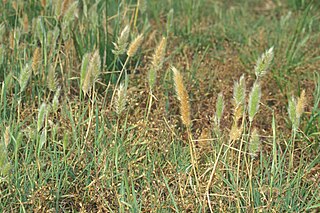
Polypogon is a nearly cosmopolitan genus of plants in the grass family, commonly known beard grass or rabbitsfoot grass.

Erechtites is a genus of flowering plants in the daisy family known commonly as fireweeds or burnweeds. They are native to the Americas and Australia, but some species are widely distributed weeds.

Tetrapogon is a genus of grasses.
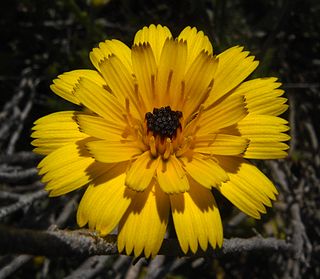
Tolpis is a genus of flowering plants in the dandelion tribe within the daisy family. Many species are limited to the Canary Islands.
Bromus pannonicus is a species of flowering plant in the family Poaceae which can be found in such European countries as Czech Republic, Hungary, Romania, and all states of former Yugoslavia.

Bromus anomalus, commonly known as nodding brome, is a species of flowering plant in the family Poaceae which can be found in such US states such as New Mexico and Texas and also in Canadian provinces such as Alberta, British Columbia, and Saskatchewan.
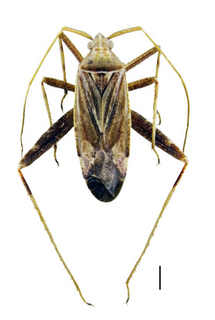
Phytocoris varipes is a species of plant bugs belonging to the family Miridae, subfamily Mirinae.
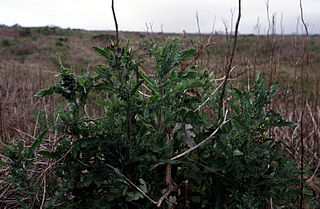
Erechtites glomeratus, common name New Zealand fireweed or cutleaf burnweed, is a species of plant in the sunflower family. It is native to Australia and New Zealand, and also naturalized on the Pacific Coast of the United States.

Bromus lanceolatus, the Mediterranean brome, large-headed brome or lanceolate brome, is a species of flowering plant in the family Poaceae. It is native to the Mediterranean, the Middle East, the Caucasus, Central Asia, Xinjiang in China, Afghanistan and Pakistan. A tetraploid, it does well in disturbed habitats and has been introduced to scattered locations in North America, South America, and central Europe.
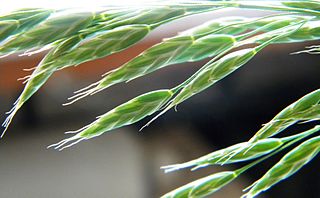
Bromus racemosus, the smooth brome or bald brome, is a species of flowering plant in the family Poaceae. It is native to subarctic and temperate Eurasia, and widely introduced elsewhere, including North America, Iceland, the Southern Cone of South America, the Korean Peninsula, Australia, and New Zealand. It grows in alkaline meadows and in waste places.

Bromus lepidus, the slender soft brome, is a species of flowering plant in the family Poaceae. It has a disjunct distribution, native to central and northern Europe, and Xinjiang in China, and introduced to an assortment of other locales, including some northeast states of the United States, the Canary Islands, and Egypt. The taxonomic history of this species has been marked by nomenclatural issues.
Bromus tomentellus, the wooly brome, is a species of flowering plant in the family Poaceae, native to Crete, Turkey, the Caucusus, the Levant, Iraq, Iran, and Turkmenistan. It is a regionally important livestock forage species.
Bromus danthoniae, the oat brome or three-awned brome, is a species of flowering plant in the family Poaceae, native to Turkey, Cyprus, the Caucasus region, the Middle East, Central Asia, Afghanistan, Pakistan, the western Himalayas, and Tibet. It is rarely discovered growing in other locations, but apparently not in sustained populations. It grows in a wide variety of habitats, and shows morphological variation due to the differing conditions in those habitats.

















